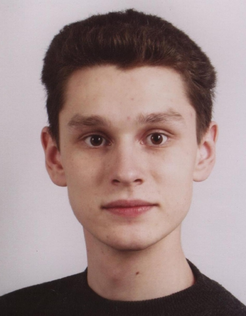Alumni 2012
Fazeel Mahmood Khan (25.1.) - Ana Lucia Uribe Uribe (1.2.) - Alexander Hansson (3.2.) - Raoul Haschke (02.05.) - Xiaoying Pang (21.5.) - Philipp Girichidis (27.6.) - Kasper Borello Schmidt (9.7.) - Natalia Sergeevna Kudryavtseva (15.10.) - Natalie Miriam Raettig (18.10.) - Tessel van der Laan (19.10.) - Dading Nugroho (31.10.) - Iwona Mochol (7.11.) - Oleksiy Golubov (9.11.) - Eva Lefa (21.11.) - Daniel Seifried (19.12.) - Ana Valente (19.12.) - Hagen Meyer (20.12.)
Ana Valente (Portugal) 19.12.2012

On the cross-correlation between weak gravitational lensing and the Sunyaev-Zel'dovich effect (thesis pdf, 11MB)
The distribution and evolution of cosmic structures, in their dark and baryonic components, remains a source of uncertainty in the current model of the Universe and is an active field of research. To address this subject, we cross-correlate the weak gravitational lensing and thermal Sunyaev-Zel’dovich effects of galaxy clusters as a function of redshift. We use the halo model of large-scale structure to estimate the two-point correlation function between the dark matter density and the gas pressure in halos. After obtaining the three-dimensional power spectrum and projecting it onto the sky by means of Limber’s approximation, we estimate how the cross-correlation between these two types of data builds up as redshift increases. We calculate the covariance matrix for a measured cross-correlation function and evaluate expected error bars for realistic surveys. Further, we examine how the choice of cosmological parameters affects our results and inspect the influence of cluster properties on the cross-correlation signal. We find that, although the cross-correlation signal does not seem to be suitable for constraining cosmological parameters, it is highly sensitive to the intrinsic properties of the clusters and thus provides a way to characterise the evolution of the halo gas component.
Supervisor: Matthias Bartelmann (ITA)
Dading Nugroho (Indonesia) 31.10.2012

Star formation properties and kinematics of nearby AGN host galaxies (thesis pdf, 11MB)
We investigate the spatially resolved kinematics properties of type 1 quasar host galaxies with redshift z < 0.2. Using combination of kinematic analysis with morphological information from optical imaging data, we diagnose the existence of disturbances in velocity field and morphology to study the importance of major merger to ignite quasar activity. We present results of 19 quasar host galaxies analysis observed with VIMOS integral field spectrograph. We construct a quantitative distortion classification scheme for the velocity fields and we demonstrate that the occurrences of distortion in the velocity fields and optical imaging are generally consistent with each other. The prevalence of mild level of distortion signatures indicates that majority of our quasars are not in the most intense part of galaxies merger process. Further, we investigate a possible relation between interaction state of the host galaxy and level of supermassive black hole activity. Using our sample, we find there is no dependency of accretion rate on neither black hole mass nor distortion state of the host galaxy and is therefore unable to support the hypothesis that major merger is the most dominant fueling mechanism to ignite quasar activity.
Supervisor: Knud Jahnke (MPIA)
Daniel Seifried (Germany) 19.12.2012

Magnetic fields during the early phase of massive star formation (thesis pdf, 9MB)
The goal of this work is to improve our current understanding of the formation process of massive stars in the presence of magnetic fields by means of numerical simulations. In particular, I focus on protostellar accretion rates, the evolution and the properties of protostellar discs and their associated outflows, and the interplay of turbulence and magnetic fields and its impact on protostellar disc formation. In a systematic parameter study I show that the accretion rates are remarkably constant over a wide range of initial conditions. Furthermore, I show that in the absence of turbulence for strong initial magnetic fields only sub-Keplerian discs can form which is attributed to the strong magnetic braking effect. This result seems to be in contrast to observational results. The morphology of the outflows, which shows a strong dependence on the initial conditions, can ultimately be linked to the structure of the underlying disc. Well-collimated outflows with high outflows velocities only develop if a Keplerian protostellar disc is present, otherwise slowly expanding, sphere-like outflows develop. Furthermore, I analyse the driving mechanism of outflows with an analytical criterion derived in the course of this work. When including supersonic, turbulent motions in the simulations, Keplerian protostellar discs form in contrast to the non-turbulent simulations. This result is in agreement with observations of early-type protostellar objects.
Supervisor: Robi Banerjee (ITA)
Hagen Meyer (Germany) 20.12.2012

The progenitors of early-type dwarf galaxies in the Virgo cluster (thesis pdf, 11MB)
In the here presented thesis, I investigate the possible progenitors of elliptical dwarf galaxies in the Virgo galaxy cluster. For the analysis of the galaxies of the late morphological type, a broadband data set in the u, g, r, i and z filters of the Sloan Digital Sky Survey was used. The photometric and structural properties (e.g. luminosity and radius) of the single morphological subclasses was compared with an existing data set of elliptical dwarf galaxies to explore the possible evolutionary connections. Within the sample, galaxies of the type "blue compact dwarf" - if the contribution of the starburst component is removed - show a remarkably good similarity to the elliptical dwarf galaxies. This agreement in the photometric properties could point to a possible evolutionary connection. The results of the photometry of the entire sample were used as input parameters for an evolutionary synthesis code, which simulates the undisturbed and disturbed evolution of the photometric parameters of the galaxies. By comparing the results of the simulation with the ones of the observations of today's elliptical dwarf galaxies, I am able to restrict the possible progenitors to certain morphological subclasses. In the course of this thesis, I was able to show that apart from "blue compact dwarf galaxies", also the prospective photometric properties of late-type spirals of the type Sd and Sm are in good agreement with today's elliptical dwarf galaxies.
Supervisor: Thorsten Lisker (ARI)
Eva Lefa (Greece) 21.11.2012

Non-thermal radiation processes in relativistic outflows from AGN (thesis pdf, 2MB)
Non-thermal, leptonic radiation processes have been extensively studied for the interpretation of the observed radiation from jets of Active Galactic Nuclei (AGN). This work addresses the synchrotron and Inverse Compton scattering (ICS) mechanisms, and investigates the potential of a self-consistent, time-dependent approach to currently unsolved problems. Furthermore, it examines how deviations from standard, one-zone models can modify the radiated spectrum. A detailed analysis of the shape of the ICS spectrum is also performed. In the first part a possible interpretation of the hard γ-ray blazar spectra in the framework of leptonic models is investigated. It is demonstrated that hard γ-ray spectra can be generated and maintained in the presence of energy losses, under the basic assumption of a narrow electron energy distribution (EED). Broader spectra can also be modeled if multiple zones contribute to the emission. In such a scheme, hard flaring events, like the one in Mkn 501 in 2009, can be successfully interpreted within a "leading blob" scenario, when one or few zones of emission become dominant. In the second part the shape of the Compton spectrum close to the maximum cutoff is investigated. Analytical approximations for the spectral shape in the cutoff region are derived for various soft photon fields, providing a direct link between the parent EED and the upscattered spectrum. Additionally, a generalization of the beaming pattern for various processes is derived, which accounts for non-stationary, anisotropic and non-homogeneous EEDs. It is shown that anisotropic EEDs may lead to radiated spectra substantially different from the isotropic case. Finally, a self-consistent, non-homogeneous model describing the synchrotron emission from stratified jets is developed. It is found that transverse jet stratification leads to characteristic features in the emitted spectrum different to expectations in homogeneous models.
Supervisor: Felix Aharonian (MPIK)
Iwona Mochol (Poland) 07.11.2012

Nonlinear waves in Poynting-flux dominated outflows (thesis pdf, 2MB)
Rotating, compact objects power some of the most spectacular phenomena in astrophysics, e.g., gamma-ray bursts, active galactic nuclei and pulsar winds. The energy is carried by Poynting flux, and the system is usually modelled using relativistic magnetohydrodynamics (MHD). However, in the relatively low density medium expected around some of these objects, the MHD approximation breaks down, allowing new, large-amplitude waves to propagate. We discuss the role of these waves in two astrophysical contexts: In blazar jets, we show that a magnetic shear, launched together with a plasma from the black hole magnetosphere, begins to accelerate particles at a large distance from its source. The resulting non-thermal emission can, nevertheless, be modulated on very short timescales, which can explain the rapid variability of the TeV gamma-ray flux observed from some blazars. In pulsar winds, we analyze the radial propagation of superluminal modes, including their damping by radiation reaction and by interaction with an external photon field. We discuss their effect on the structure of the pulsar wind termination shock, presenting new solutions in which the non-linear wave is asymptotically matched to the constant pressure surroundings. The observational implications of these solutions are discussed for both isolated pulsars, and pulsars in binary systems.
Supervisor: John Kirk (MPIK)
Tessel van der Laan (The Netherlands) 19.10.2012

Circumnuclear star forming rings in the barred galaxies NGC5248 and NGC6951 (thesis pdf, 11MB)
In this thesis I study the gas distribution and dynamics, as well as the stellar populations, in the circumnuclear star forming rings in the nearby barred galaxies NGC5248 and NGC6951. Circumnuclear star forming rings are regions of high gas and star formation density in the centers of disk galaxies. These star formation rings can have a strong influence on the secular evolution of their host galaxies, by halting gas inflow towards the nucleus. The gas masses that build up in these rings are high and this consequently leads to intense star formation. This makes circumnuclear star forming rings also an important tool to build up the stellar (pseudo-)bulge. These two galaxies were selected because they have very similar global properties (mass, size, metallicity), but very different circumnuclear regions, both of which containing circumnuclear star forming rings. Detailed investigation of both, and a comparison between them, thus provides new detailed insight on the interplay between circumnuclear star forming rings and the circumnuclear region as a whole. Three questions are addressed in this work. First of all, I investigate the true effectiveness of the circumnuclear rings as a gas barrier in both galaxies. I study star formation progression in these rings and its relation to the gas flow onto the ring. The age and life span of the circumnuclear rings is derived from the analysis of their stellar populations. In both galaxies I find that while the circumnuclear rings are effective barriers, they are not absolute ones. The interplay between the large scale stellar bar, circumnuclear ring and other dynamical components in the circumnuclear region allows some gas to flow towards the very center past the ring. I find that the location of the youngest stars in the ring is close to the inflow position of the gas onto the ring in both galaxies, consistent with star formation proceeding in a ’pearls-on-a-string’ mechanism with the youngest ’pearls’ close to the gas inflow location. Finally, I derive ages of the rings around 1.5 Gyr, which implies that circumnuclear star forming rings have a significant amount of time to shape the circumnuclear regions of their host galaxies.
Supervisors: Eva Schinnerer / Hans-Walter Rix (MPIA)
Natalie Miriam Raettig (Germany) 18.10.2012

Global Baroclinic Instability and its Implications on Planet Formation (thesis pdf, 60MB)
In this thesis we analyze a form of non magneto hydrodynamic turbulence which could be described as disk weather since it forms vortices due to baroclinic effects. We want to find out if and how these vortices influences planet formation. The focus is on angular momentum transport and how efficient vortices can trap particles. We estimate disk properties from observations and derive radial Brunt-Vaisala frequencies as well as cooling time-scales. Then we analyze the baroclinic amplification of vortices and the particle concentration therein. We use 2D as well as 3D local shear- ing box simulations with the PENCIL CODE to investigate the problems. In 2D, we conduct a comprehensive study of a broad range of various entropy gradients, thermal cooling and thermal relaxation times covering the parameter space relevant for protoplanetary disks. We measure the Reynolds stresses as a function of our control parameters and see that there is angular momentum transport even for entropy gradients as low as beta equiv −d ln S/d ln r = 1/2. The amplification-rate of the perturbations appears to be proportional to beta^2. The saturation level of Reynolds stresses on the other hand seems to be proportional to beta^1/2. All entropy gradients will lead to Reynolds stresses of 10^−3 − 10^−2 which shows that baroclinic vortices are a feasible mechanism for transporting angular momentum. The concentration of particles of different sizes in baroclinic vortices is first analyzed in 2 dimensions. Because we expect strong particle accumulations, particle feedback onto the gas is included. Particles accumulate inside the vortices and the local dust-to-gas ratios become high enough to trigger the streaming instability even for initial dust-to-gas ratios as low as epsilon_0 = 10^−4. In 3 dimensional unstratified gas simulations we verify previous result. Once particles, that feel vertical gravity, with normalized friction times of St = 0.05 and St = 1.0, and epsilon_0 = 0.01 are included, the vortex column in the mid-plane is strongly perturbed. Yet, when the initial dust-to-gas ratio is decreased the vortices remain stable and function as efficient particle traps. Streaming instability is triggered even for the lowest epsilon_0 = 10^−4 and smallest particle sizes (St = 0.05) we assumed, showing a path for planetesimal formation in vortex cores from even low global amounts of cm-sized particles.
Supervisor: Hubert Klahr (MPIA)
Natalia Sergeevna Kudryavtseva (Russia) 15.10.2012

Micro-arcsecond astrometry of exoplanet host stars and starburst clusters (thesis pdf, 4MB)
Since the first star catalogues tremendous progress in the astrometric accuracy of positional observations has been achieved. In this thesis, I show how beneficial astrometric techniques are already today for the study of starburst clusters, and how astrometry will fundamentally improve our knowledge on exoplanets in the near future. I first study two galactic starburst clusters, Westerlund 1 (Wd 1) and NGC 3603 YC, which are among the most massive young clusters in our Galaxy. I perform astrometric and photometric analyses of adaptive optics and Hubble Space Telescope observations of these clusters in order to understand on which time-scales these clusters formed. As a result, I derive upper limits for the age spreads of 0.4 Myr for the 4 to 5 Myr old cluster Wd 1, and 0.1 Myr for the 1 to 2 Myr old NGC 3603 YC. Thus, the star formation process in each of these clusters happened almost instantaneously. The second part of this thesis deals with the dynamical properties and the initial mass function (IMF) of Wd 1. Astrometric analysis of multi-epoch, near-infrared adaptive optics observations of Wd 1 was used to distinguish the cluster's members from field stars. This lead to an unbiased determination of the internal velocity dispersion of the cluster, and an IMF slope of Gamma = -0.46 for the core of the cluster (R < 0.23 pc). The final part of this thesis is devoted to the future prospects of detecting exoplanets with the GRAVITY instrument. The second-generation Very Large Telescope Interferometer instrument GRAVITY aims at achieving 10 μas accuracy. Here, I discuss the possibilities of detecting and characterizing exoplanets with masses down to a few Earth masses with the high sensitivity provided by GRAVITY, in addition to providing an initial target list.
Supervisors: Wolfgang Brandner / Stefan Hippler (MPIA)
Oleksiy Golubov (Ukrainia) 09.11.2012

Modelling the Milky Way Disc (thesis pdf, 4MB)
RAVE, SEGUE and Hipparcos data are used to study the dynamics of stars in the extended solar neighbourhood. The asymmetric drift of thin disc dwarfs is studied as a function of colour and metallicity. Linear extrapolation of the data falls within the error bars from Aumer & Binney (2009) for local standard of rest. The observed metallicity dependence of the asymmetric drift is consistent with the known radial metallicity distribution in the disc. Implying the asymmetric drift correction to the SEGUE data allows us to reconstruct the behaviour of the rotation curve of the Milky Way in the extended solar neighbourhood. The rotation curve appears to be eßentially flat, giving no hint for a dip just outside the solar radius followed by an increase observed in some other data sets. The data are supplemented by tangent point measurements for the inner rotation curve. Thus a synthetic rotation curve of the Milky Way is obtained. It is fitted by a density model consisting of a Dehnen bulge, an exponential disc with a hole, and a flattened dark matter halo with either cored isothermal or NFW density profile. In this fitting the parameters are constrained to reproduce the local surface density of the disc and the local volume density of the halo, which are known from local stellar dynamics in the solar neighbourhood. Thus the density model of the Milky Way is reconstructed. The vertical structure of the disc of theMilkyWay is consistent with the model by Just & Jahreiß (2010). Some basic features of distribution functions of the Milky Way and of the dynamical heating are also discussed.
Supervisor: Andreas Just (ARI)
Kasper Borello Schmidt (Denmark) 09.07.2012

Frontiers of Galaxy Evolution: Time-Domain Observations and 3D Spectroscopy (thesis pdf, 10MB)
Understanding the formation and evolution of galaxies through cosmic time has been a central focus of astrophysics in the last decades: how did the interplay between dark matter structure formation, star formation, galaxy merging, and active galactic nuclei (AGN) give rise to the observed galaxy properties at different redshifts? This thesis presents innovative observational approaches to two aspects of this problem: finding and studying AGN through their variability, and making a first systematic census of galaxy mergers at z > 1 through three-dimensional spectroscopy.
First we present a new and simple technique for selecting extensive, complete, and pure quasar samples via their intrinsic variability, parameterizing the single-band light-curve structure function through a power-law to identify quasars among other variable and non-variable sources. Using extensive multi-epoch observations from SDSS Stripe 82 containing ~60 epochs taken over 8 years, we demonstrate the power of this approach. The presented algorithm identifies quasars with a completeness and purity above 90% at all redshifts. Even for Pan-STARRS 1 mock data of only 6 epochs over 3 years, variability is still an encouragingly efficiencycient quasar classifier. Data on intrinsic quasar variability enable a wide range of astrophysical science. We quantify the color variability, confirming and greatly fleshing out previous claims, that quasars become bluer as they brighten. We find a strong redshift dependence of this blueing, which we can attribute to emission lines contributing to the SDSS bands at different redshifts. We find that the color variations of single quasars are much more pronounced than the ranges in color seen in time-averaged ensembles of quasars. This indicates, that the observed color variations cannot be explained by changes in the mean steady state AGN accretion rate, but must arise from accretion disk ‘hotspots’ or similar phenomena.
In the second, distinct part of the thesis, we present the first large sample of morphologically selected galaxy mergers with three-dimensional spectroscopy at z~1.5. With individual masses and star formation rates derived from multi-band photometry, we created emission line maps from the slitless grism spectroscopy of 3D-HST as proxy for star formation maps, providing a comprehensive empirical picture of where star formation takes place in galaxy mergers at the epoch, where the cosmic star formation and merger rates peaked. We find that a broad range of star formation morphologies occur at all redshifts, irrespective of star formation rate and total stellar mass, in these mergers. An initial illustrative comparison to a set of cosmological simulations shows, that simulated mergers with similar mass and gas content show star formation in both merger components far more often than for the observed 3D-HST mergers. This suggests that mergers at z~1.5 most commonly happen between galaxies of distinctly different gas fractions.
Supervisor: Hans-Walter Rix (MPIA)
Philipp Girichidis (Germany) 27.06.2012
Importance of the initial conditions for star formation (thesis pdf, 10MB)
This thesis investigates the impact of the initial conditions on present-day star formation. Using numerical simulations, we follow the gravitational collapse of dense molecular clouds under different initial turbulent motions and initial density distributions. Our analysis focuses on the morphology of the cloud, the time and location of the formation of stars, the energetics during the collapse, the formation of clusters including their internal structure, their accretion behaviour as well as their mass distribution. The morphology of the cloud and the total number of stars are strongly influenced by the initial type of turbulence and the initial density profile. The results range from almost unperturbed cores with a single star to strongly filamentary cores with hundreds of stars in disconnected clusters. The internal structure of protostellar clusters is systematically but not significantly influenced by the initial conditions. Concerning the accretion rates as well as the dynamical interactions of stars within the clusters, we observe a fairly uniform behaviour, not reflecting the large variations in the initial conditions. The simulations presented in this thesis were performed using the grid-based code FLASH, developed mainly at the University of Chicago.
Supervisor: Robi Banerjee (ITA)
Xiaoying Pang (China) 21.05.2012

A comprehensive study of the young star cluster HD 97950 in NGC 3603 (thesis pdf, 15MB)
I study the young massive star cluster HD,97950 located in the Galactic giant HII region NGC,3603. My goals are (1) to estimate the survival probability of the cluster, (2) to investigate the origin of its mass segregation, and (3) to investigate the interplay between the cluster and the surrounding interstellar medium (ISM). All the studies are done with data of the Hubble Space Telescope. I determine the cluster velocity dispersion from the stars' relative proper motions, and calculate the virial mass of the cluster. The cluster star formation efficiency is estimated to be about 50%, which suggests that the HD97950 cluster will most likely survive as a bound cluster to gas expulsion. I apply the Lambda minimum spanning tree technique to measure the mass segregation down to 30,Msun. The high-mass stars are more segregated than low-mass stars, implying that the mass segregation in HD97950 is mostly of dynamical origin. To improve the age determination for the cluster stars that are severely reddened by the surrounding dusty ISM, I compute a pixel-to-pixel distribution of the gas reddening, E(B-V)g, associated with the cluster. The radial profiles of E(B-V)g show significant spatial variations around HD97950. Using UBVRI photometry, I estimate the stellar reddening of cluster stars. After correcting for foreground reddening, the total to selective extinction ratio in the cluster is RV=3.49 pm 0.79. The extinction curve in the UBVRI filters in the cluster is greyer than the average Galactic extinction laws, but close to the extinction law for starburst galaxies. This indicates that stellar feedback from massive stars changes the dust properties in the HD,97950 cluster in a similar way as in starburst galaxies.
Supervisor: Eva Grebel (ARI)
Raoul Haschke (Germany) 02.05.2012

Structure, Abundances, and Reddening of the Magellanic Clouds from its variable stars (thesis pdf, 40MB)
Using the data obtained by the Optical Gravitational Lensing Experiment (OGLE) we investigate the properties of the old population of the Magellanic Clouds (MCs) using the variable RRLyrae stars and of the young population traced by Cepheids. With our own reddening estimates, we deduce distances to the RR Lyrae stars and Cepheids. These distances are used to determine structural parameters, such as scale height, position angle and inclination of the Large Magellanic Cloud (LMC) and Small Magellanic Cloud (SMC). The depth extent of the SMC is significantly higher than for the LMC. For the SMC a quite different orientation of the young Cepheids is found in comparison to the old RR Lyrae stars. One of the most interesting results is the off-center bar of the LMC, which extends for up to ∼ 5 kpc in both populations out of the disk. We determine metallicities for single RRLyrae stars and the metallicity distribution functions reveal significant differences between the LMC and SMC. The mean metallicity of the SMC is ∼ 0.2 dex lower. This leads to the conclusion of a different early enrichment history of the MCs. Investigating RRLyrae stars in the OGLE field towards the Galactic bulge, we obtain reddening estimates, metallicities and distances to the bulge and to a small part of the Sagittarius stream. The stream has a significantly lower metallicity and seems to be inclined. Performing a spectroscopic analysis of individual element abundances of nine very metal-poor candidate RRLyrae stars, we find the most metal-poor star ([Fe/H] = −2.7 dex) yet detected in theMCs. The other very metal-poor stars have abundances leading to the conclusion that a build-up of the Galactic halo from a merger with a MC-type galaxy is plausible.
Supervisor: Eva Grebel (ARI)
Ana Lucia Uribe Uribe (Colombia) 01.02.2012

The migration of planets in protoplanetary disks (thesis pdf, 15MB)
This thesis presents a numerical study on the interaction between planets and circumstellar disks. We use the hydrodynamics/magnetohydrodynamics code PLUTO (Mignone et al, 2007) to simulate the circustellar accretion disk. A module to include embedded planets was incorporated into the code. We study two critical aspects for planet formation theory: the migration of planets due to gravitational disk torques and the accretion of gas onto planets from the surrounding disk. These two aspects are critical in any planet formation model as they will determine the final mass and the orbital separation. We first investigate aspects for massive planets in the evolutionary phase when a gap has been cleared in the disk. It is found that when a gap has been opened, the migration and gas accretion rate is linearly dependent on the surface density inside the gap. The torques exerted on the planet depend strongly on the material inside the Hill sphere when the local disk mass exceeds the planet mass. The depletion of the Hill sphere due to an accreting planet can increase migration timescales up to an order of magnitude of the linear estimate. Secondly, we investigate migration and gas accretion in turbulent disks, where turbulence is generated by the magnetorotational instability (MRI). In weakly magnetized turbulent disks, low-mass planet migration is dominated by stochastic density perturbations that can be characterized with a given amplitude and correlation time. More massive planets can undergo slower or reversed migration due to unsaturation of the corotation torque by turbulent advection and diffusion of gas into the horseshoe region. Magnetic turbulence is greatly supressed by giant planets that open a gap in the disk. Additionally, Jupiter-mass planets in turbulent disks are found to accrete less than expected from the global-averaged interal stresses in the disk. Our results can be directly implemented in planet population synthesis studies in order to better understand the nature of the observed population of extrasolar planets.
Supervisors: Hubert Klahr / Thomas Henning (MPIA)
Alexander Hansson (Sweden) 03.02.2012

The dependence of present-day galaxy properties on environmentand mass (thesis pdf, 17MB)
In this thesis I show that only some of the commonly used stellar populations models can account for observed broad-band colors of the local galaxy population. Through a stellar population synthesis modeling, including the ects of dust, I show that a galaxy's star formation history, stellar mass, chemical enrichment and dust extinction can be constrained over a large part of the parameter space using optical broad band photometry. An essientially volume complete sample of nearby (<50Mpc) galaxies in the Sloan Digital Sky Survey are selected and u,g,r,i,z-band photometry for these galaxies are measured from the survey images. Using my stellar population synthesis modeling I obtain the aforementioned properties and study how these, along with galaxy sizes and shapes, depend on galaxy stellar mass and environment. In addition, these galaxy properties are related to the mass functions of galaxy groups providing further insight into galaxy assembly. Moreover, I have performed an imaging study of the Abell 569 cluster core revealing signs of galaxy interactions as well as a galaxy luminosity function with a at faint end slope.
Supervisor: Thorsten Lisker (ARI)
Fazeel Mahmood Khan (Pakistan) 25.01.2012

Dynamics and Evolution of Supermassive Black Holes in Merging Galaxies (thesis pdf, 12MB)
Supermassive black holes (SMBHs) are ubiquitous in galaxy centers and are correlated with their hosts in fundamental ways, suggesting an intimate link between SMBH and galaxy evolution. In the paradigm of hierarchical galaxy formation this correlation demands prompt coalescence of SMBH binaries, presumably due to dynamical friction, interaction of stars and gas with the binary and finally due to gravitational wave emission. If they are able to coalesce in less than a Hubble time, SMBH binaries will be a promising source of gravitational waves for gravitational wave detectors. However, it has been suggested that SMBH binaries may stall at a separation of 1 parsec. This stalling is sometimes referred to as the Final Parsec Problem (FPP). This study uses N-body simulations to test an improved formula for the orbital decay of SMBHs due to dynamical friction. Using a large set of N-body simulations, we show that the FPP does not occur in galaxies formed via mergers. The non spherical shape of the merger remnants ensures a constant supply of stars for the binary to interact with. On its way to coalescence, the SMBH binary ejects several times its total mass in stars and leads to the formation of the cores observed at the center of giant ellipticals. The results of this study also support a cosmological scenario where the prompt coalescence of SMBHs following galaxy mergers is common and where SMBH binaries are promising sources of gravitational waves at low and high redshifts.
Supervisor: Andreas Just (ARI)
